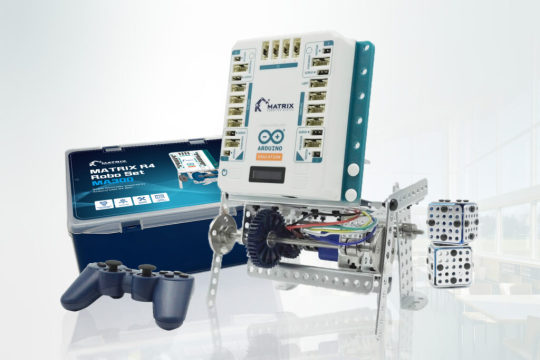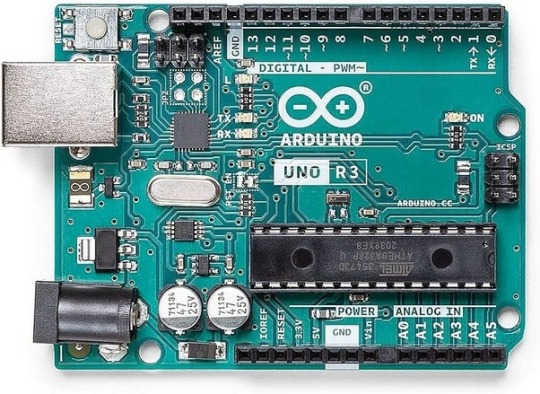#Arduino Education
Explore tagged Tumblr posts
Text
MATRIX Robotics System unveils MATRIX R4 Robo Set in Collaboration with Arduino Education
In July, the Taiwanese-based company MATRIX Robotics System marked a significant milestone in educational robotics with the release of its latest product: the MATRIX R4 Robo Set. Developed in partnership with and certified by Arduino Education, this innovative robotics set is built on the UNO R4 WiFi platform, providing users with a sophisticated 12- in 1 robot model and versatile tool to explore…

View On WordPress
#AMR#Arduino#Arduino Education#MA300#MARC#Master AI Robot Cup Competition#Matrix#Plug & Play#R4#R4 Robo Set#Robot Kit#Robotic Set
0 notes
Text
Robotics Training
In the technologically advanced world of today, robotics has become a crucial sector that is reshaping industries and developing novel answers to difficult problems. Training in robotics has become crucial for both individuals and companies hoping to succeed in this ever-changing field. From novices to experts, systematic robotics instruction gives students the tools they need to efficiently design, program, and manage robotic systems.
The Importance of Robotics Training
Training in robotics helps close the gap between theory and real-world implementation. Understanding robotics is now essential as automation and artificial intelligence become more pervasive in industries including manufacturing, healthcare, agriculture, and logistics.
Types of Robotics Training Programs
Beginner Courses
Advanced Training
Industry-Specific Training
Certifications and Diplomas
Benefits of Robotics Training
Improved Opportunities for Careers:
Experts in robotics are highly sought after in a variety of businesses.
Certification programs enhance employment opportunities and give resumes more legitimacy.
Creativity & Innovation:
Learning robotics inspires students to think creatively and develop ground-breaking technology.
Practical Education:
Training programs have a strong emphasis on hands-on experience, enabling students to construct working robots and work on real-world projects.
Teamwork:
Interdisciplinary collaboration is common in robotics, which promotes communication and teamwork abilities.
Popular Robotics Training Platforms
Coursera and edX
Udemy and Skillshare
VEX Robotics and FIRST Robotics
University Programs
Learning robotics is more than just becoming proficient with technology; it's about getting ready for a time when automation and robots will be a big part of our everyday life. Investing in robotics training can result in rewarding opportunities and a happy career, regardless of whether you're a professional trying to advance your skills or a student hoping to enter the sector. Maintaining your edge with the correct training will enable you to participate in this revolutionary journey as robotics continues to advance.
To know more, click here.
3 notes
·
View notes
Text
Mastering Neural Networks: A Deep Dive into Combining Technologies
How Can Two Trained Neural Networks Be Combined?
Introduction
In the ever-evolving world of artificial intelligence (AI), neural networks have emerged as a cornerstone technology, driving advancements across various fields. But have you ever wondered how combining two trained neural networks can enhance their performance and capabilities? Let’s dive deep into the fascinating world of neural networks and explore how combining them can open new horizons in AI.
Basics of Neural Networks
What is a Neural Network?
Neural networks, inspired by the human brain, consist of interconnected nodes or "neurons" that work together to process and analyze data. These networks can identify patterns, recognize images, understand speech, and even generate human-like text. Think of them as a complex web of connections where each neuron contributes to the overall decision-making process.
How Neural Networks Work
Neural networks function by receiving inputs, processing them through hidden layers, and producing outputs. They learn from data by adjusting the weights of connections between neurons, thus improving their ability to predict or classify new data. Imagine a neural network as a black box that continuously refines its understanding based on the information it processes.
Types of Neural Networks
From simple feedforward networks to complex convolutional and recurrent networks, neural networks come in various forms, each designed for specific tasks. Feedforward networks are great for straightforward tasks, while convolutional neural networks (CNNs) excel in image recognition, and recurrent neural networks (RNNs) are ideal for sequential data like text or speech.
Why Combine Neural Networks?
Advantages of Combining Neural Networks
Combining neural networks can significantly enhance their performance, accuracy, and generalization capabilities. By leveraging the strengths of different networks, we can create a more robust and versatile model. Think of it as assembling a team where each member brings unique skills to tackle complex problems.
Applications in Real-World Scenarios
In real-world applications, combining neural networks can lead to breakthroughs in fields like healthcare, finance, and autonomous systems. For example, in medical diagnostics, combining networks can improve the accuracy of disease detection, while in finance, it can enhance the prediction of stock market trends.
Methods of Combining Neural Networks
Ensemble Learning
Ensemble learning involves training multiple neural networks and combining their predictions to improve accuracy. This approach reduces the risk of overfitting and enhances the model's generalization capabilities.
Bagging
Bagging, or Bootstrap Aggregating, trains multiple versions of a model on different subsets of the data and combines their predictions. This method is simple yet effective in reducing variance and improving model stability.
Boosting
Boosting focuses on training sequential models, where each model attempts to correct the errors of its predecessor. This iterative process leads to a powerful combined model that performs well even on difficult tasks.
Stacking
Stacking involves training multiple models and using a "meta-learner" to combine their outputs. This technique leverages the strengths of different models, resulting in superior overall performance.
Transfer Learning
Transfer learning is a method where a pre-trained neural network is fine-tuned on a new task. This approach is particularly useful when data is scarce, allowing us to leverage the knowledge acquired from previous tasks.
Concept of Transfer Learning
In transfer learning, a model trained on a large dataset is adapted to a smaller, related task. For instance, a model trained on millions of images can be fine-tuned to recognize specific objects in a new dataset.
How to Implement Transfer Learning
To implement transfer learning, we start with a pretrained model, freeze some layers to retain their knowledge, and fine-tune the remaining layers on the new task. This method saves time and computational resources while achieving impressive results.
Advantages of Transfer Learning
Transfer learning enables quicker training times and improved performance, especially when dealing with limited data. It’s like standing on the shoulders of giants, leveraging the vast knowledge accumulated from previous tasks.
Neural Network Fusion
Neural network fusion involves merging multiple networks into a single, unified model. This method combines the strengths of different architectures to create a more powerful and versatile network.
Definition of Neural Network Fusion
Neural network fusion integrates different networks at various stages, such as combining their outputs or merging their internal layers. This approach can enhance the model's ability to handle diverse tasks and data types.
Types of Neural Network Fusion
There are several types of neural network fusion, including early fusion, where networks are combined at the input level, and late fusion, where their outputs are merged. Each type has its own advantages depending on the task at hand.
Implementing Fusion Techniques
To implement neural network fusion, we can combine the outputs of different networks using techniques like averaging, weighted voting, or more sophisticated methods like learning a fusion model. The choice of technique depends on the specific requirements of the task.
Cascade Network
Cascade networks involve feeding the output of one neural network as input to another. This approach creates a layered structure where each network focuses on different aspects of the task.
What is a Cascade Network?
A cascade network is a hierarchical structure where multiple networks are connected in series. Each network refines the outputs of the previous one, leading to progressively better performance.
Advantages and Applications of Cascade Networks
Cascade networks are particularly useful in complex tasks where different stages of processing are required. For example, in image processing, a cascade network can progressively enhance image quality, leading to more accurate recognition.
Practical Examples
Image Recognition
In image recognition, combining CNNs with ensemble methods can improve accuracy and robustness. For instance, a network trained on general image data can be combined with a network fine-tuned for specific object recognition, leading to superior performance.
Natural Language Processing
In natural language processing (NLP), combining RNNs with transfer learning can enhance the understanding of text. A pre-trained language model can be fine-tuned for specific tasks like sentiment analysis or text generation, resulting in more accurate and nuanced outputs.
Predictive Analytics
In predictive analytics, combining different types of networks can improve the accuracy of predictions. For example, a network trained on historical data can be combined with a network that analyzes real-time data, leading to more accurate forecasts.
Challenges and Solutions
Technical Challenges
Combining neural networks can be technically challenging, requiring careful tuning and integration. Ensuring compatibility between different networks and avoiding overfitting are critical considerations.
Data Challenges
Data-related challenges include ensuring the availability of diverse and high-quality data for training. Managing data complexity and avoiding biases are essential for achieving accurate and reliable results.
Possible Solutions
To overcome these challenges, it’s crucial to adopt a systematic approach to model integration, including careful preprocessing of data and rigorous validation of models. Utilizing advanced tools and frameworks can also facilitate the process.
Tools and Frameworks
Popular Tools for Combining Neural Networks
Tools like TensorFlow, PyTorch, and Keras provide extensive support for combining neural networks. These platforms offer a wide range of functionalities and ease of use, making them ideal for both beginners and experts.
Frameworks to Use
Frameworks like Scikit-learn, Apache MXNet, and Microsoft Cognitive Toolkit offer specialized support for ensemble learning, transfer learning, and neural network fusion. These frameworks provide robust tools for developing and deploying combined neural network models.
Future of Combining Neural Networks
Emerging Trends
Emerging trends in combining neural networks include the use of advanced ensemble techniques, the integration of neural networks with other AI models, and the development of more sophisticated fusion methods.
Potential Developments
Future developments may include the creation of more powerful and efficient neural network architectures, enhanced transfer learning techniques, and the integration of neural networks with other technologies like quantum computing.
Case Studies
Successful Examples in Industry
In healthcare, combining neural networks has led to significant improvements in disease diagnosis and treatment recommendations. For example, combining CNNs with RNNs has enhanced the accuracy of medical image analysis and patient monitoring.
Lessons Learned from Case Studies
Key lessons from successful case studies include the importance of data quality, the need for careful model tuning, and the benefits of leveraging diverse neural network architectures to address complex problems.
Online Course
I have came across over many online courses. But finally found something very great platform to save your time and money.
1.Prag Robotics_ TBridge
2.Coursera
Best Practices
Strategies for Effective Combination
Effective strategies for combining neural networks include using ensemble methods to enhance performance, leveraging transfer learning to save time and resources, and adopting a systematic approach to model integration.
Avoiding Common Pitfalls
Common pitfalls to avoid include overfitting, ignoring data quality, and underestimating the complexity of model integration. By being aware of these challenges, we can develop more robust and effective combined neural network models.
Conclusion
Combining two trained neural networks can significantly enhance their capabilities, leading to more accurate and versatile AI models. Whether through ensemble learning, transfer learning, or neural network fusion, the potential benefits are immense. By adopting the right strategies and tools, we can unlock new possibilities in AI and drive advancements across various fields.
FAQs
What is the easiest method to combine neural networks?
The easiest method is ensemble learning, where multiple models are combined to improve performance and accuracy.
Can different types of neural networks be combined?
Yes, different types of neural networks, such as CNNs and RNNs, can be combined to leverage their unique strengths.
What are the typical challenges in combining neural networks?
Challenges include technical integration, data quality, and avoiding overfitting. Careful planning and validation are essential.
How does combining neural networks enhance performance?
Combining neural networks enhances performance by leveraging diverse models, reducing errors, and improving generalization.
Is combining neural networks beneficial for small datasets?
Yes, combining neural networks can be beneficial for small datasets, especially when using techniques like transfer learning to leverage knowledge from larger datasets.
#artificialintelligence#coding#raspberrypi#iot#stem#programming#science#arduinoproject#engineer#electricalengineering#robotic#robotica#machinelearning#electrical#diy#arduinouno#education#manufacturing#stemeducation#robotics#robot#technology#engineering#robots#arduino#electronics#automation#tech#innovation#ai
4 notes
·
View notes
Text
youtube
#robotics for kids#robotics#kids#stem#k12#education#kids learning#kids robotics#arduino#microbit#Youtube
1 note
·
View note
Text
Empowering Young Innovators: The Importance of Arduino and Robotics Classes for Kids in Mumbai
In today's rapidly advancing technological landscape, equipping children with foundational skills in coding and robotics is no longer optional—it's essential. Mumbai is a bustling metropolis known for its educational institutions and technology-driven initiatives, offering numerous opportunities for young minds to explore the world of technology. Among the most effective platforms for this exploration is the Arduino programming language, a versatile and user-friendly tool that introduces kids to the basics of coding and electronics.

Why Arduino Programming?
Arduino Programming is an open-source electronics platform that utilizes simple software and hardware. Its accessibility and ease of use make it an ideal starting point for beginners. Children learn to create interactive electronic objects through hands-on projects, fostering creativity and problem-solving skills.
Robotics Classes: Bridging Theory and Practice
While coding provides the theoretical foundation, robotics brings these concepts to life. Robotics classes for kids in Mumbai integrate coding with mechanical design, allowing students to build and program their robots. This interdisciplinary approach enhances critical thinking, teamwork, and innovation.
Technobotics: Pioneering STEM Education
Technobotics is one of Mumbai's leading centres for Arduino and robotics education. With more than 15 years of experience, Technobotics has played a key role in connecting theoretical knowledge with practical application. Their Arduino programming course spans 15 sessions, each lasting 1.5 hours, catering to children aged 10 and above. The curriculum covers various topics, including digital and analogue sensors, wireless communication, and modulation techniques like PWM.
By the end of the course, students not only grasp the fundamentals of Arduino but also develop a mindset geared towards innovation and problem-solving.
The Broader Impact of STEM Education
Involving children in STEM (Science, Technology, Engineering, and Mathematics) education through platforms like Arduino and robotics classes fosters a growth mindset. It encourages curiosity, resilience, and a passion for continuous learning. As these young learners navigate challenges and devise solutions, they cultivate indispensable skills in the 21st century. Moreover, early exposure to such disciplines can spark interest in future engineering, computer science, and technology careers.
Conclusion
Incorporating Arduino programming and robotics into children's education is more than just learning to code—it's about preparing them for a future where technology is ubiquitous. Mumbai's vibrant educational ecosystem, with institutions like Technobotics leading the way, provides the perfect environment for nurturing the next generation of innovators. By investing in such programs, we empower our children to not only understand the world around them but also to shape it.
For parents and educators in Mumbai seeking to introduce children to the world of technology, exploring Arduino programming and robotics classes is a step towards fostering a generation of thinkers, creators, and problem-solvers.
#Arduino For Kids#Robotics Classes Mumbai#Kids Coding Classes#STEM Education Mumbai#Technobotics#Robotics For Kids#Future Innovators
0 notes
Text
Build your FIRST. ROBOT. (It's WAY easier than you think!)
This DIY kit is your ticket to the world of robotics. Perfect for beginners, ages 15+. Learn engineering, coding basics, and create something AWESOME.
Watch this thing MOVE! Get yours & build with your friends!
#DIYrobot#robotics#STEM#engineering#buildityourself#robot#project#education#tech#science#coding#arduino#makers#robotcar#fun#learning#technology
0 notes
Text
Best Robot Car Kit for Kids
Looking for an engaging way to introduce your kids to robotics and programming? The ELEGOO UNO R3 Smart Robot Car Kit is a fantastic choice. It’s designed to give children hands-on experience with electronics and coding. This kit includes everything you need to build a smart robot car. With parts like obstacle avoidance and line tracing modules, and the option to control it via a smartphone, it’s…

View On WordPress
0 notes
Text
MIT team wins grand prize at NASA’s First Nations Launch High-Power Rocket Competition
New Post has been published on https://thedigitalinsider.com/mit-team-wins-grand-prize-at-nasas-first-nations-launch-high-power-rocket-competition/
MIT team wins grand prize at NASA’s First Nations Launch High-Power Rocket Competition


The members of the MIT First Nations Launch team had never built a drone before when they faced the 2024 NASA First Nations Launch High-Power Rocket Competition. This year’s challenge invited teams to design, build, and launch a high-power rocket carrying a scientific payload that deploys mid-air and safely returns to the ground, integrating Indigenous methodologies.
The eight-student team of all Indigenous students earned the compatition’s grand prize, as well as first place in the written portion.
Deploying a drone from a rocket
Building even the simplest drone demands precise calculations of weight, power, and functionality. But this drone had extra layers of complexity. It needed to fold inside the 7.5-inch diameter rocket and deploy to a full 16 x 16-inch configuration. Team captain and rising junior Hailey Polson explains: “The arms of the drone, which hold the propellers, need to lock in place. Once it unfolds, you don’t want it to re-fold while you’re trying to fly it around. Therefore, you need to have some kind of locking mechanism, as well as a mechanism to ensure it extends and unfolds properly.”
Deploying the drone from the rocket presented a significant challenge. The competition required that the drone’s separation from the rocket could not rely on gravity. To ensure successful deployment, the students planned to use a black powder charge to push the drone from an interior rail, but they had no prior experience testing explosives to see if it would work as intended. So, the team enlisted the expertise of their friends from the MIT Rocket Team, who helped conduct black powder testing in the MIT blast chamber.
Despite all these difficulties, the team decided to rise to the challenges of the competition yet again by designing their own parachute release mechanism, while many teams opted for commercial ones. They used an Arduino controller, a servo, and a special snap shackle. “We tested around 15 different ones because it’s pretty difficult to find something that a servo motor can easily pull and actually release in the correct way,” Polson says.
Once the parachute is released, the drone must be piloted to a safe landing. Nicole McGaa ’24 and second-year student Alex Zhindon-Romero took the FAA Part 107 drone pilot exam so they could legally pilot the drone.
The advantages of an all-indigenous team
According to a 2021 report from the U.S. National Science Foundation, Native Americans formed only 0.6 percent of the STEM workforce.
Polson grew up on the Cherokee Nation Reservation of Claremore, Oklahoma, where she enjoyed being surrounded by other people in her tribe and celebrating her rich culture. “I want to set an example for other people from my background that they can attend MIT, be a rocket scientist, and do basically anything they want and still feel connected to their community.”
Polson planned to join an Edgerton Center build team when she came to MIT, “but I never imagined there would be enough interest for an all-Indigenous build team,” she says. “It’s special because any build team forms a unique bond between the members and fosters a great sense of community. However, having that extra layer of shared values, aspirations, and backgrounds has really gone a long way in driving us towards the same goals. We are not only committed to excellence in engineering and achieving the tasks they ask of us, but also to helping each other and finding excellence within ourselves as engineers.”
The MIT First Nations Launch team was formed in 2022 to participate in the annual NASA Artemis student challenge. The team uses Indigenous methodologies and structures to learn and understand how engineers can shape the world through aerospace and beyond. Polson describes their Indigenous approach as “prioritizing both the human aspect, focusing on the interactions between our teammates, and making sure that they are getting everything they need out of this, as well as on the impacts beyond that, with outreach, education, and the environment.”
Professor J. Kim Vandiver, director of the Edgerton Center, says, “We non-Native American engineers have a lot to learn from these students. I am particularly drawn to their more holistic view of life and the interconnectedness of everything we do and the world in which we live.”
#2022#2024#aerospace#air#approach#Arduino#Awards#honors and fellowships#background#Building#challenge#Clubs and activities#Collaboration#Community#competition#complexity#Contests and academic competitions#deploying#deployment#Design#Diversity and Inclusion#driving#drone#Edgerton#education#engineering#engineers#Environment#explosives#Forms
0 notes
Text
A4988 Pinout: A Comprehensive Guide
Discover the functionality and versatility of the Stepper Motor Driver Module A4988 Pinout, a crucial component in the world of robotics and automation. Let’s delve into the key details, with a specific focus on the A4988 pinout for a clearer understanding.
Stepper Motor Driver Module A4988
The A4988 is a stepper motor driver module that plays a pivotal role in controlling the precise movements of stepper motors. Whether you’re working on a 3D printer, CNC machine, or any other project requiring accurate motor control, the A4988 is a go-to choice.
A4988 Pinout Configuration
Understanding the A4988 pinout configuration is essential for effectively integrating the A4988 into your projects. Here’s a breakdown of the key pins:
MS1, MS2, MS3 (Microstep Resolution): These pins determine the microstep resolution, allowing you to set the stepping mode for the stepper motor. Configuring these pins enables fine-tuning of motor movement.
VMOT (Motor Power Supply Voltage): Connect this pin to the motor power supply voltage (typically 8V to 35V) to ensure the proper functioning of the stepper motor.
GND (Ground): Establish the ground connection by linking this pin to the ground of your power supply or microcontroller.
VDD (Logic Power Supply Voltage): Provide the logic power supply voltage (typically 3V to 5.5V) to this pin to power the internal logic circuitry of the A4988.
DIR (Direction Input): Control the direction of the stepper motor by connecting this pin to a digital output on your microcontroller.
STEP (Step Input): Trigger individual steps of the stepper motor by connecting this pin to another digital output on your microcontroller.
RESET (Reset Input): This pin resets the internal translator circuit, and it is optional to use.
SLEEP (Sleep Input): Putting the A4988 into sleep mode is achieved by connecting this pin to a digital high signal.
Read More: A4988 Pinout
#A4988#stepper-motor#microcontroller#Arduino#Raspberry-Pi#electronics#pinout#wiring#tutorial#DIY#project#hardware#software#programming#electronics-projects#microcontroller-projects#Arduino-projects#Raspberry-Pi-projects#open-source#maker#fabrication#prototyping#engineering#technology#innovation#learning#education
0 notes
Text
oooohhg its been a Hot minute since i used ArcGIS [well, now i have to use qgis lol] and man! I know how i want to visualize this data but i completely forget the terms. I found it tho!!! Literally as i was typing this haha. Proportional symbols, thats exactly what i was thinking of, awesome!!
I’m only here for a skosh today, i did the majority of my hours yesterday and wednesday yippee
I got my whiteboard set up [didnt know it was extendable! Neat!], pilfered a marker, been jammin to music since *no one* else is here, overall havin a good day!
I gotta make sure i have everything i need for the program next week, if i don’t i gotta send a materials list :p oh! thats right, i was gonna ask for a second monitor…….
Hey i got a real trash can too! Before it was a cardboard box hahaha
Fingers crossed my grants get approved so we can get a 3-D printer and that Arduino education kit
Also send good vibes, I’ve been goin hardcore ham on html for two websites for myself and next week I’m gonna start learning the basics of c++ to get some idea of what I’m doing with the kit. it does say no experience necessary but i’ve been wanting to use arduino for ages, i’m gonna heckin learn it for real!
There���s like. a lot that i have planned lmao its gonna b so cool
#patch.talks#patch.4h#patch.STEM#stem#patch does stem education#sees the program’s access to arduino kits: its free real estate
1 note
·
View note
Text
Robotics Courses in the USA
With applications in fields including healthcare, manufacturing, logistics, and even entertainment, the robotics sector is expanding rapidly. Pursuing a robotics education in the USA provides a route to a fulfilling and exciting career as the need for qualified robotics specialists increases. The USA, which is well-known for its technical innovations, is home to some of the top universities and institutes in the world that provide state-of-the-art robotics programs.
Key Areas of Study in Robotics Courses
Mechanical Design and Kinematics
Artificial Intelligence and Machine Learning
Sensors and Perception
Control Systems
Human-Robot Interaction
Embedded Systems
Career Opportunities in Robotics
With applications in fields including healthcare, manufacturing, logistics, and even entertainment, the robotics sector is expanding rapidly. Pursuing a robotics education in the USA provides a route to a fulfilling and exciting career as the need for qualified robotics specialists increases. The USA, which is well-known for its technical innovations, is home to some of the top universities and institutes in the world that provide state-of-the-art robotics programs.
How to Apply for Robotics Courses in the USA
Research Programs: Find colleges and courses of study that complement your professional objectives.
Fulfill Admission Requirements: For graduate programs, the majority of institutions require GRE scores in addition to a solid academic background in computer science, engineering, or related subjects.
Prepare your application materials, which usually consist of a resume, recommendation letters, and a statement of purpose.
Apply Online: Before the deadline, send in your application via the university's website.
Attend Interviews: As part of the selection process, some schools may need you to attend an interview.
Taking a robotics course in the USA gives you the abilities and information you need to succeed in one of the most fascinating and quickly expanding industries. Whether your goal is to develop autonomous systems, AI-powered robots, or healthcare robotics, the United States of America provides unparalleled educational options and professional chances. Investigate robotics programs now to invest in your future and take the lead in the technological revolution.
To know more, click here.
0 notes
Text
Teaching Kids the Basics of Electronics and Coding with Arduino
Are you looking for a fun, hands-on way to introduce your kids to the world of electronics and coding? Look no further than Arduino!
Arduino is an open-source platform that allows users to create and control electronic projects through coding. This makes it an excellent tool for introducing kids to the basics of Electronics and coding in a way that is both engaging and accessible.

One of the best things about Arduino is its versatility. You can create a wide range of projects, from light-up robots to temperature sensors, all using the same platform. This means that there’s no limit to what your kids can create with Arduino, and it’s a great way to encourage their creativity and problem-solving skills.
Getting started with Arduino is easier than you might think. The platform is designed to be user-friendly, with plenty of resources available Online to help beginners get started. There are also countless tutorials and project ideas available, making it easy to find inspiration and start creating right away.

Photo by Arnold Francisca on Unsplash
One fun project that kids can create with Arduino is a light-up Robot. Using simple components like LEDs, resistors, and a servo motor, kids can create a robot that can move and light up in response to different stimuli. For example, they could create a robot that moves forward when it senses light or one that spins in circles when it hears a sound.
Another great project to try is a Temperature Sensor. With a few basic components and some simple Coding, your kids can create a sensor that can measure the temperature in a room and display the results on an LCD screen. This is a great way to introduce them to the basics of programming and engineering while also teaching them about the importance of temperature control.
Overall, Arduino is an excellent tool for introducing kids to the world of electronics and coding. Its versatility, ease of use, and endless possibilities make it a fun and engaging way to encourage creativity, problem-solving, and STEM learning. So why not give it a try and see what kind of amazing projects your kids can create?
#artificial intelligence#coding#education#programming#coding for kids#digital world#future#innovation#tech#coding course#coding for beginners#engineering#programmer#javascript#learn to code#arduino#3d printing#smart house#smart
0 notes
Text
0 notes
Text
Embark on Your Robotic Journey: Beginner's Guide to Programming
https://technobotics.in/
Explore the exciting world of robotics! This guide covers everything about autonomous robotics for beginners, to kickstart your learning journey. Dive into the fascinating world of robotics programming! Learn the basics, write your first code, and unleash your creativity with ease.

0 notes
Text
youtube
🎉Watch the special episode prepared just for you. Welcome to the Back to School 2023 Sale!
📌https://www.elecrow.com/back-to-school-sale
#back to school#back to school 2023#back to school sale#raspberry pi#open source#arduino#elecrow#steam education#electronics#Youtube
0 notes
Text

project's gist: https://gist.github.com/Sarverott/3b352c6c3fe1c3d13f3faf642cc3b23c
0 notes